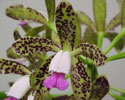|
|
|
|
|
| |
Flasks of
Cattleya guttata var. leopoldii 'Profpam' × self |
|
| |
|
|
| |
|
|
Click to Enlarge

Pod Parent Flower |
|
|
|
| |
Culture Notes from Donor: Parent plant: Temperature range I (60-83°F), high light.
Comments: Parent plant: Tall plant with tall inflorescence. Very fragrant.
For additional origin/habitat information supplied courtesy of
Charles and Margaret Baker, see further below, near the bottom of this page.
|
Temperatures we attempt to use in the lab & greenhouse:
| For Species: |
|
Spring, Summer, Autumn: days average 85°F, nights 68°F; best fit is Warm-Intermediate 87-64°F
(Source:
Baker's Web OSC) |
| For Species: |
|
Winter: days average 77°F, nights 58°F; best fit is Cool-Intermediate 75-58°F
(Source:
Baker's Web OSC) |
| For Genus: |
|
Spring, Summer, Autumn, Winter: days average 83°F, nights 60°F; best fit is Intermediate 83-60°F
(
) |
|
About the name...
| Etymology of |
Cattleya |
|
Named in honor of William Cattley, English horticulturist in the 19th century.
(Source:
Pridgeon 1992) |
| Etymology of |
guttata |
|
From Latin "guttatus" spotted.
(Source:
Mayr & Schmucker 1998) |
| Etymology of |
leopoldii |
|
Named for Leopold II, Belgian king in the 19th century.
(Source:
Mayr & Schmucker 1998) |
| Pronunciation of |
Cattleya |
|
KAT-lee-ya
(Sources:
Pridgeon 1992, Hawkes 1978) |
| Pronunciation of |
guttata |
|
goo-TAH-ta
(Source:
Hawkes 1978) |
| Pronunciation of |
leopoldii |
|
LAY-oh-pold-ee-eye
(Source:
Hawkes 1978) |
|
If you would like to direct someone to this web page, please copy and paste this URL into your email:
http://troymeyers.com/d?013512
| Flask Information |
| Availability: |
Seed not viable- failed. We were not able to make any flasks. |
| You should: |
Consider placing a "Notify Retries" Request, and if an identical pollination (the same parents) is done again, we'll let you know. |
|
You might also want to:
|
View the seed assay for this item.
View items of the same species.
View items of the same genus.
|
| Ordering Information |
| You are not currently logged in. |
|
You must be a registered user and be logged in to reserve a flask or place a notification request. Please log in:
|
|
|
|
|
|
| |
The origin/habitat information below is supplied courtesy of Charles and Margaret Baker
The following information is based on the name of the plant provided by the donor, and assumes that the name is correct. If the plant has been misidentified, then the following information may not be correct.
This text is copyrighted by the Bakers and may not be reproduced without permission.
ORIGIN/HABITAT: Brazil. Plants are found in swamps very near the coast
from near Rio de Janeiro southward to near Paranagua. The habitat
originally extended southward through the states of Rio de Janeiro, São
Paulo, Parana, Santa Catarina, and Rio Grande do Sol to almost the Uruguay
border. However, modern Brazilian writers report that the southern part of
the habitat has been destroyed and plants are no longer found there.
Cattleya tigrina usually grows in the tops of trees in dense swampy
forests below 350 ft. (100 m). Cattleya guttata Lindley is found in the
same area but spreads further inland and grows to somewhat higher
elevations.
More about this information and the Bakers...
|
|
|
| |
|
|
|